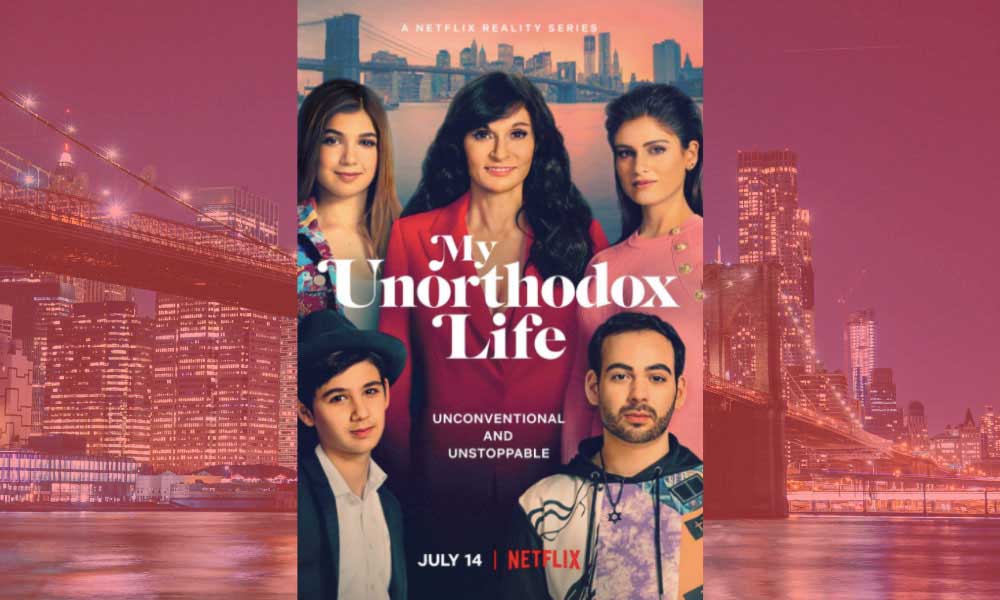

Julia’s story is one that some Jews will resonate with, and some won’t. Just like Love, Simo n cannot possibly be representative of all gay people and Fresh Off the Boat cannot possibly be representative of all immigrants, My Unorthodox Life cannot possibly be representative of all Orthodox Jews. It is unfortunate that the first shows and movies about historically underrepresented groups tend to be seen as representatives of the whole. Upset that Aron has stopped talking to girls for fear of sinning, Julia tells her son that there are “millions of modern Orthodox Jews who keep shabbos and kosher who don’t feel this way.” Julia’s ex-husband tells Aron that one of the great things about Judaism is that “there’s no one-size-fits-all.” “No, I see it,” Haart replies, and the two embrace.Įven with the variety of cast members, it is of course true that My Unorthodox Life is not wholly representative of Orthodox Jews.

“I’m happy, if anyone was wondering,” Hannah says. This emphasis on personal choice comes through on screen in Haart’s interactions with her sister Hannah, an observant Orthodox Jew. ” While Julia pushes her children to become exposed to different types of thinking, members of the Haart family each choose to practice their own level of observance-and all are accepted for what they ultimately decide. The show doesn’t just follow the shellfish-eating Haart, but instead tracks her whole family: There’s Batsheva, her influencer daughter, who has a loving marriage with a man she wed in Monsey Shlomo, her son, who observes Shabbat and says he always will and Aron, a self-described “black hatter,” who chooses to be “in the middle” between “modern and Yeshivish. īut for all of this kvetching, the show is more nuanced than most have given it credit for.
#My unorthodox life ratings series#
This poorly-acted scene has more straw-men than hay fields in Iowa it borders on mental abuse it wouldn’t fly if “Julia” tried to convince a 14 year old transgender to change, and doesn’t have such a series on Muslims because the bigotry in it wouldn’t stand a day.
#My unorthodox life ratings tv#
The Orthodox Jewish Public Affairs Council has tweeted out several critiques, including calling a scene in which Haart cries in front of Aron because he no longer wants to talk to girls or watch TV borderline “mental abuse.” A social media campaign aims to combat Haart’s narrative by encouraging “proud frum men and women” to post about their “satisfying, healthy and fulfilling Orthodox lives,” along with the hashtag #MyOrthodoxLife. Several Jewish newspapers have run negative reviews critiquing the show as vapid and unrepresentative of Orthodox Jews. My Unorthodox Life is receiving intense backlash. She shares custody of her fourth child, Aron, who splits his time between her ex-husband’s house in Monsey and Haart’s Manhattan penthouse.

She had four children with her ex-husband, three of whom have left Monsey and live elsewhere in New York. Haart launched a shoe company and quickly rose in the fashion industry, becoming CEO of the modeling and talent agency Elite World Group. So frustrated with Orthodoxy’s restrictive rules that she became suicidal, she secretly started selling insurance, saved up and took off to start a new life. Īt 42, Haart left an Orthodox Jewish community in Monsey, NY for a largely secular life in Manhattan. Love her or hate her, one thing is clear: Julia Haart, the 50-year-old self-described ultra-Orthodox Jew turned fashion mogul and star of Netflix’s newest reality show My Unorthodox Life, has a whole lot of chutzpah.


 0 kommentar(er)
0 kommentar(er)
